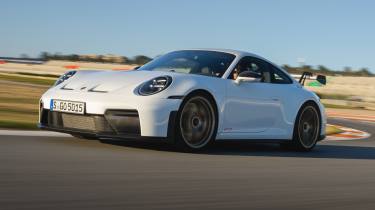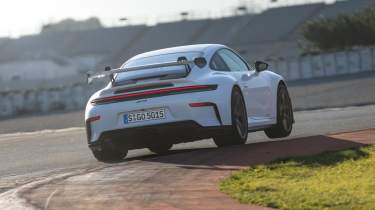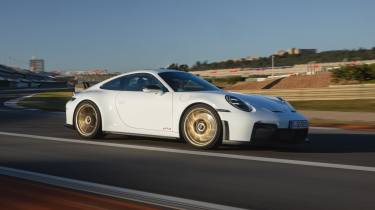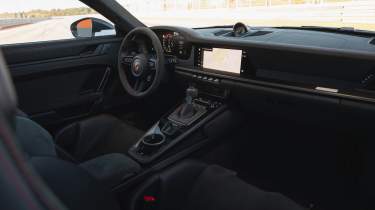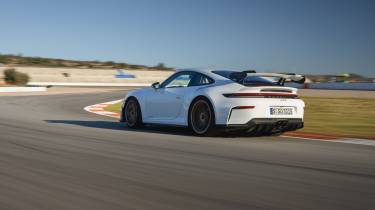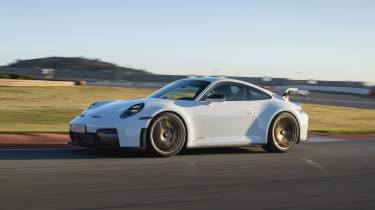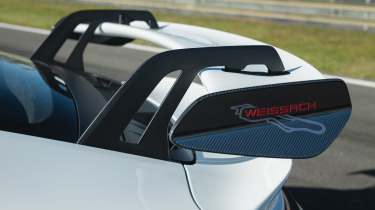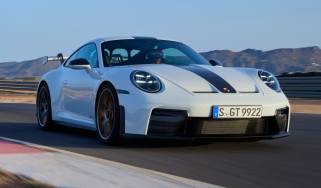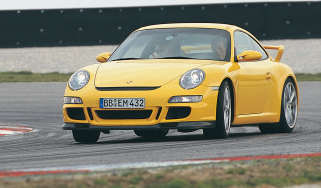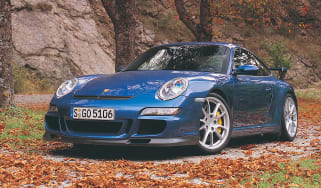Porsche 911 GT3 (992.2) 2025 review – the best GT3 yet?
The 2025 992.2 Porsche 911 GT3 uses know-how from the 992.1 GT3 RS and the 911 S/T. Has the GT3 formula been perfected?
The current, 992-generation Porsche 911 family is in the midst of its ‘992.2’ mid-life update phase, which began with the hybrid 911 Carrera GTS and standard 911 Carrera. Soon enough the 911 Turbo will be getting its own glow-up. First though, the latest Porsche 911 GT3.
A particular kind of 911 for a particular kind of customer, and in some ways, the trickiest car for the engineers within Porsche’s GT division to keep alive without losing its essential magic. The ever-tightening regulatory framework around all new production cars is making the qualities that have come to define the GT3 – naturally aspirated engine, 9000rpm redline, light weight, an ‘analogue’ character in an increasingly digitised world – much harder to homologate.
Nonetheless, the car we meet in the pitlane at the Ricardo Tormo race circuit in Spain has neither turbochargers nor hybrid assistance, redlines at 9k (albeit now on a digital rev-counter) and weighs no more than its predecessor (providing you tick the boxes for various lightweight options). Two 911 GT3 body styles are available from launch: the ‘regular’ winged GT3, and the more understated GT3 Touring, without the rear wing. (And, for the first time, the Touring is now available with the option of rear seats.)
2025 Porsche 911 GT3 in detail
To comply with tightened exhaust particulate regs in multiple global markets (40 per cent tougher in America than those the original 992.1 GT3 had to meet in 2021, and 50 per cent in China), there are now four catalytic converters in the exhaust system and multiple detail changes to the engine and wider powertrain, including redesigned individual throttle bodies and various cooling measures.
More reviews
Peak torque is a little less than before (332lb ft rather than 347lb ft), and to compensate Porsche has given the GT3 lower gear ratios. You can spec the GT3 with a six-speed manual, or a seven-speed PDK, and both have eight per cent shorter gearing than before. (The manual is the same gearbox fitted to the limited-run Porsche 911 S/T.)
A little bit of top speed is sacrificed as a result but tractive force on the wheels is stronger all the way through the gears, making the GT3 feel more urgent than ever. And this has never been a car about top speed; of all 911s, this one is all about corners. It still sounds superb at high revs too, judging from the shriek of the cars streaking past on the circuit’s start-finish straight outside.
The suspension has had plenty of attention too, and learned a few tricks from the S/T. The software for the adaptive dampers has been updated for faster response, helping both ride comfort and wheel control on rougher roads. The bump stops have been redesigned, allowing greater spring travel and smoother control as the suspension begins to reach the limits of its travel. This helps both in compressions and also when clobbering kerbs on track – and track driving is as strong a part of the car’s rationale as ever.
There’s a lower pivot point for the front double-wishbone suspension, giving the GT3 some of the same anti-dive properties as the 992.1 Porsche 911 GT3 RS. The RS’s aerodynamic teardrop-shaped front trailing arms, which contribute to downforce at high speeds, have been adopted, too.
Some of the most visible changes are in the interior. Controversially, the GT3 adopts the latest all-digital instrument panel, deleting the analogue rev-counter that has been a 911 mainstay since day dot. It’s still in the centre, however, and it is now clearer to read at night, particularly for glasses wearers. One neat touch is that, in Track mode, it rotates to place its redline at 12 o’clock, as per a classic competition car.
Aside from Track, which gives the bare minimum of information, including temperatures and tyre pressures, there are two other displays: Normal and Sport, the latter giving you extra gearshift indicator graphics.
The GT3 carries all of the driver assistance systems which are now essentially legally required – lane keep assist, speed limit warning, and so on – but a physical switch brings them all up on the touchscreen swiftly, enabling you to toggle them on and off without digging through various menus and submenus.
The biggest interior change is the presence of rear seats as an option in the GT3 Touring (but not the ‘normal’ GT3). That’s been made possible by a new folding carbon bucket seat, which has an extra neat party piece: if you’re wearing a helmet on track, you can unclip the headrest cushion to stop it getting in the way. It’s all been thought through.
Apples to apples, the new 992.2 GT3 would be roughly 20kg heavier than the original 992, due to altered doors for safety regs, thicker front brake discs for and the various aforementioned technical additions (the extra cats add 4kg, for example). However, Porsche has managed to claw back all of those extra kilos with new carbonfibre suspension elements (including the rear shear panel, which saves 4kg on its own), thinner carpets and various other gram-saving elements.
To get the full effect, buyers will need to spec the £19,531 Weissach package, which saves 12kg versus standard: bootlid, roof, wing and other elements (including the rear anti-roll bars) in carbonfibre, along with lightweight door inners, six-point harnesses and the further option of a carbon rear rollcage.
The electric power steering system has been upgraded too, also based on learnings from the S/T. An automatic friction compensation system recalibrates the steering according to wear and temperature for the most consistent feel possible, and Porsche promises a more precise but less flighty response just off-centre.
So against the odds, the GT3 has retained the on-paper attributes of its forebears, and potentially made gains in agility too. A step forward or a case of running to stand still? Let’s find out.
Settling into the driver’s seat – the new folding carbon bucket option – the driving position is as motorsport-style low-slung as ever. The new digital display ahead is crisp and clear and while it’s a little bit of an emotional wrench to lose a physical tacho, you quickly forget about it. Especially when your eyes are on stalks, following a GT3 RS pace car ahead being driven by one of Porsche’s professional drivers, who is clearly enjoying himself.
The circuit isn’t the place to fully appreciate the characteristics of the new steering, given that on a track you make bigger inputs under higher load than you would on the road. But it is very precise, and though it’s perhaps a little light in weight for my tastes, it offers plenty of feedback without being upset by the circuit’s (admittedly fairly smooth) cambers and kerbs. As before, the front steering works in conjunction with rear-wheel steering, and it’s a smooth and subtle system which avoids feeling unnatural or intrusive.
Precision is the word for the brakes too: with six-piston monobloc calipers at the front (four- at the rear) and composite discs, feedback through the pedal is reassuring and stopping power consistent, lap after lap. The anti-dive geometry helps too: stability under braking, even while turning (there are a few tricky compound corners here at Valencia, with curved approaches under braking) is very impressive.
The GT3 feels almost like a racing car rather than a road car, given its stability in both roll and pitch, and its consistency lap after lap. Even when the tyres (Michelin Pilot Sport Cup 2 Rs) begin to get hot, the balance doesn’t change significantly.
There’s immense traction – always a strong suit of 911s, given their weight distribution – and the electronically controlled differential lock and torque vectoring in this PDK-equipped car works very well. Out of slow corners, there’s that satisfying sense of the car’s tail hunkering down and propelling itself forward. With such smooth power and torque delivery, it flatters your own throttle control, too. Despite the lower gearing, it’s rare to overwhelm the rear tyres. Rare to miss an apex at the front too: the GT3’s front axle is keen, and if you do ever begin to blur into understeer, easing off and tweaking the wheel quickly brings it into line.
Despite all that grip, it’s still a playful car if you want it to be. If anything, on the sticky tyres it feels overgripped and perhaps some drivers might crave a wilder car with more sledgehammer torque delivery but this isn’t that kind of car: the combination of precise, neat and tidy handling yet a malleable balance at the limit remains one of the GT3’s key strengths.
The PDK gearbox shifts as swiftly and crisply as ever, and in Track mode it downshifts so promptly in automatic mode that you can leave it to its own devices while learning the circuit without ever being caught in the wrong gear at the wrong time.
We also hop into the passenger seat of a manual car for a passenger ride with former Porsche factory racing driver Jörg Bergmeister, who played a key role in the new GT3’s development.
He’s not shy about using Valencia’s kerbs, and explains (at lower revs; up in the 9000rpm stratosphere, the GT3 is still a pretty noisy car inside, despite the new exhaust measures – and a great-sounding one too, it must be said) that the new bump-stop arrangement has helped a great deal both over the kerbs and in the car’s finer body control in extremis – ‘it’s more precise, the damper platform absorbs bumps more smoothly.’
> Porsche 911 GT3 group test – 996 takes on 997
We’re yet to drive the ‘regular’ 992.2 Porsche 911 GT3 on the road – winged cars were reserved for circuit use only. We have, however, driven the GT3 Touring on the road, with a manual gearbox, our review of which you'll see soon.
Based on the circuit, the new Porsche 911 GT3 is a thoroughly impressive car, building on the strengths of its predecessor to become even more stable and consistent on track, but retaining a playful yet confidence-inspiring handling balance.
It’s retained the key attributes of the original 992, taken on elements of the 911 S/T without stepping on that car’s toes and allowed customers more customisation options. In 992.2 form, the 911 GT3 remains one of the best drivers’ cars money can buy (£157,300 to be precise, with either body style and either gearbox).
A thorough in-depth review of both the 911 GT3 and GT3 Touring will be in the next issue of evo magazine, out 12 February 2025.
2025 Porsche 911 GT3 specs
| Engine | Flat-six, 3996cc |
|---|---|
| Power | 503bhp @ 8500 |
| Torque | 332lb ft |
| Weight | 1420kg |
| Power-to-weight | 360bhp/ton |
| Tyres | Michelin Plot Sport Cup 2 R |
| 0-62mph | 3.4sec (with PDK) |
| Top speed | 194mph (with manual) |
| Basic price | £157,300 |
